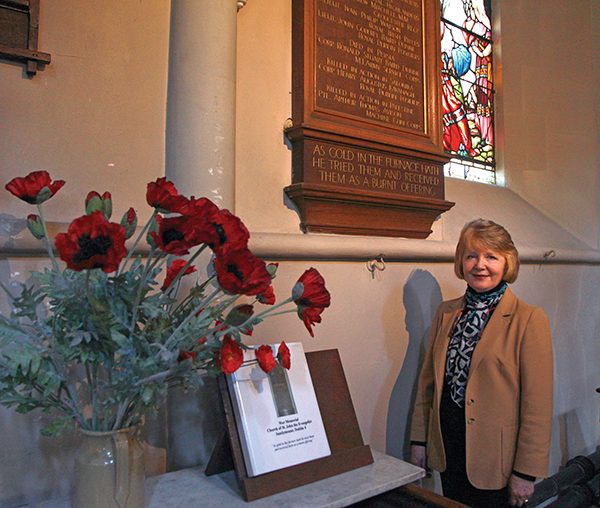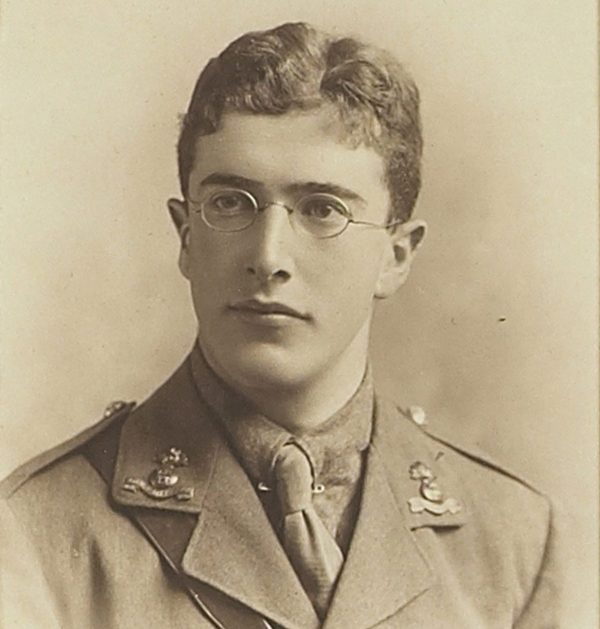
Pictured Above: Alyson Gavin beside the memorial at St. John the Evangelist Church, Sandymount.
Photo by Maria Shields O’Kelly.
Alyson Gavin, local resident of Sandymount, genealogist and church warden of St. John the Evangelist Church, spoke to NewsFour about the memorial plaque to the local men who fought in WW1.
“The reason why I started to research the war memorial was because I was saddened by the fact that little was known about the men listed on the memorial since nobody in the present congregation had any links on them. The war memorial was erected by the congregation in 1920. We’ve spent a lot of time and effort in St. John’s finding out about the lives of men who died and maybe that is something that all churches should consider doing, so the names on such memorials don’t become just a list of unknown persons of the past.”

Above: Second Lieutenant Arthur Charles De Burgh Daly, from the Fourth Battalion of the Royal Dublin Fusiliers, who died in the First World War.
Daly was the nephew of celebrated Irish songwriter Percy French on his mother’s side. He was educated at Caius College Cambridge and trained at a school in Kent, where he became a member of the Officer Training Corps.
He enlisted with the Dublin Fusiliers in August 1915 following his elder brother Ulick De Burgh Daly into action, who after receiving wounds at Richebourg l’Avoue and a crippling case of appendicitis was sent home from the war.
Arthur De Burgh Daly joined the same special reserve regiment that his older brother had previously served with and was sent into action on July 19th, 1916 in time for the start of the tragic Somme offensive, where over 57,000 casualties were recorded on the disastrous first day alone.
Lt. De Burgh Daly, saw action at the battle of Guillemont in July 1916 and at the battle of Ginchy in September 1916, where he was to come to an untimely end. From one of his letters he wrote, “We attack Ginchy tomorrow. In case of accidents, I played the game two days ago, and will, please God, tomorrow,” in his last letter home to his parents.
Due to an administration error, De Burgh Daly’s family received a telegram on the 18th of September 1916 giving his date of death to be the 4th of September. However, a letter had arrived from Charles in meantime to his family, dated the 8th of September, the day before his real death.
His family had assumed that some mistake had been made and desperately hoped that he might still be alive. Dr. Charles De Burgh Daly Snr. (Charles’s father) wrote to the War Office pleading for clarification. The War Office eventually established that the wrong date had erroneously been given.
According to an account by a Sergeant Wilson of C Company, Arthur De Burgh Daly led his men into action and was wounded twice, and lying within a shell hole, he said to Sergeant Wilson “It’s not bad enough to stop me from going on.” After about five yards advance, he was hit by machine gun fire that killed him instantly at the German front line.
He was “universally liked” and a “keen and a useful officer” and admired for his “great courage” before he met his end. This report was passed on with great sympathy from Sergeant Wilson to his older brother Ulick. He died prematurely at the age of 19. He is buried at Delville Wood cemetery in Longueval France.
During this time, De Burgh Daly’s sister Lucy, was in the Voluntary Aid Detachment (VAD) nursing service, where she served in various hospitals around Dublin and at a British army base in Boulogne before being demobilized in 1919.
One name on the memorial in St. John’s Church is that of Edward Stafford King Harman, who was the heir to the vast estate of Rockingham, Boyle, Co. Roscommon and heir to his family barony. The family moved to Taney, Dundrum but were parishioners of St. John’s Anglican Church, Sandymount. He married Olive Pakenham-Mahon of Strokestown Park, Co. Longford and after joining the Irish Guards in 1911, he was later posted to Flanders in September 1914.
He was reported missing after intense fighting at Klein Zillebeke on the 6th of November 1916. Reports indicate that Harman’s company were holding the front line and were subsequently surrounded and cut off from the main body of British troops. There was some doubt as to whether he had been killed or captured as a British prisoner of war, as witness accounts differed.
Subsequently, over the following eight months, Edward’s family wrote continuously to the war office, seeking confirmation and an indication of his status and the possible location of his body in France. In June 1915, the family were finally notified that he was listed as “killed in action in Ypres” in Flanders on the 6th of November 1914.
Posthumously, he was promoted to the rank of Captain in the midst of confusion surrounding his death. Edward Stafford King Harmon was honoured in the Irish Life magazine dated the 30th of July 1915 in a supplement entitled “our heroes from Mons to the Somme August 1914 to July 1916.”
“He was with Captain Lord John Hamilton in the front trench with a company of their regiment when they were surrounded and cut off by the Germans. Captain Stafford-King-Harman was a very keen soldier and a good sportsman. His death has caused widespread regret in the County Roscommon, where he was extremely popular with all classes.”
Another name on the memorial is Private John Drew Mitchell of 21 Ailesbury Road, son of Frank William Drew Mitchell (the Secretary of the Congested Districts Board) and Emily Wild. He died on the exact same day as Charles De Burgh Daly, at the battle of Ginchy. As trooper J.D Mitchell, he transferred from the Royal Horse Guards to the First Battalion, the Gloucestershire Regiment on May 13th, 1916 and he entered the conflict on May 23rd. He received a fatal wound while serving with the Gloucesters and died in action, aged 28. He was buried at Heily Station Cemetery, Mericourt- L’Abbé.
“Most of the men were members of the congregation and they are buried in diverse locations such as France, Greece, Palestine and even Iran,” said Gavin. “We can look forward to the state commemoration of the Somme in Islandbridge, which will be the Saturday before National Commemoration Sunday.”
By Robert Fullarton



